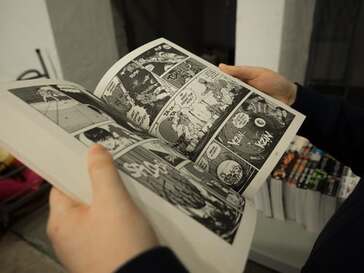 by Christopher M. Comparri The appeal of books, movies, television and any sort of story-telling platform can be boiled down to two key components: having a great story and having great characters to fill out said story. As viewers and readers, we often find ourselves rooting for certain characters and despising others to the pits of our very soul. This can be for any number of reasons: rooting for the underdog, finding a character that is relatable, finding one that embodies the essence of what we feel is right or wrong with the world. Finding the handful of characters that you feel strongly about builds an emotional tie between the content produced and the individual consuming it. However, the trend of incorporating huge casts of characters into stories is now having an adverse effect. People are finding too many characters to like or hate in passing. These characters are being masked as huge markers in a story, but the reality is quite different. In literature, sometimes less is more. Large casts of characters aren’t necessary to drive a story forward and are adding very little value.
Huge casts of characters often lead to confusion for the audience and can even cause potential consumers of the content to be put off by the sheer numbers of the cast. The most recent example of a series that suffers from this trend is Game of Thrones. With articles titled "All 52 Game of Thrones Main Characters Ranked," it’s easy to see why people become confused. Fifty-two main characters? How is anyone supposed to keep up with all of them? The worst part about it is that a healthy portion of the Game of Thrones cast can be cut out in favor of a handful of truly vital characters. Anyone that has watched the show or read the books can likely whittle down the truly important players to ten people or less. If asked to recall the characters they felt a real emotional connection to, that number would likely mirror and closely match the important players in the overall narrative. F. Scott Fitzgerald said, “Plot is character, character is plot.” While casts of characters are becoming larger and larger, the importance of characters seems to be diminishing. One of the most popular Japanese mangas, or graphic comic books, Naruto has an immense list of characters. In some regards, this vast number of characters can promote a greater connection with a wider audience. Richard Eisenbeis, a writer for two of the most well-known and visited websites for video game and Japanese pop culture news, ign.com and kotaku.com, noted the good that comes from having a diverse and robust cast: “With 700 chapters, there’s time for nearly every single character to be given a distinct personality and background—especially the ones that come into direct conflict with Naruto at one point or another.” From start to finish, the English adaptation of the manga had seventy two volumes, which were released between 2003 and 2015. Taking twelve years and seventy two volumes to tell one story is bordering on absurd. When you take into account all of the characters that are introduced and how rapidly they fade into the background, things get pushed over the edge. There will be moments where allies of the core main protagonists shine brightly, even eclipsing them in terms of overall ability. Furthermore, Eisenbeis points out that by the end of the story, unfortunately, these characters are barely mentioned or seen as anything other than being a part of the background noise that is supporting the main protagonists: “Unfortunately, these characters are often established and then simply forgotten about as the story once again refocuses on Naruto, Sakura, or Sasuke. This is a bit of a double-edged sword as, more often than not, the side characters are more interesting than the main three—especially more so than Naruto himself.” There is certainly something to be said about the success of stories that contain such a robust pool of characters for a reader or audience to choose from. When a show like Game of Thrones or a manga like Naruto introduces the number of characters that they do, there is an opportunity to connect with an even wider audience. Rather than have a reader feel like they are somewhat similar to one character, with a huge pool of characters to choose from, they are far more likely to find one that more closely fits to who they are. Still, getting lost in characters can be detrimental to storytelling. When you have only a small group of people to focus on, such as in classics like Of Mice and Men and The Great Gatsby, the reader is forced to really notice the nuances and ticks that drive the development of both the characters and the plot. As readers we become enraptured and lost in characters like Nick Carraway and Jay Gatsby, they are able to see the story develop around them and watch them evolve as the story progresses. Stories that focus on characters to drive plot, as well as plots that drive characters, create memorable and truly rooted characters in a purposeful way that so many novels and movies have moved away from. Behind most stories with large character casts, you can often whittle the cast down to less than fifty percent of what the author has introduced and have just as robust of a tale. Having huge casts of characters that often act as nothing more than a foil for character development for the main protagonists makes the overall story suffer. Storytelling, in one’s medium of choice, is best done when the characters introduced are integral to the storyline rather than “fluff” character who were clearly written to cater to the widest audience possible.
0 Comments
Leave a Reply. |
Archives
July 2024
Categories
All
|
|
Glassworks is a publication of Rowan University's Master of Arts in Writing 260 Victoria Street • Glassboro, New Jersey 08028 [email protected] |
All Content on this Site (c) 2024 Glassworks
|

 RSS Feed
RSS Feed
